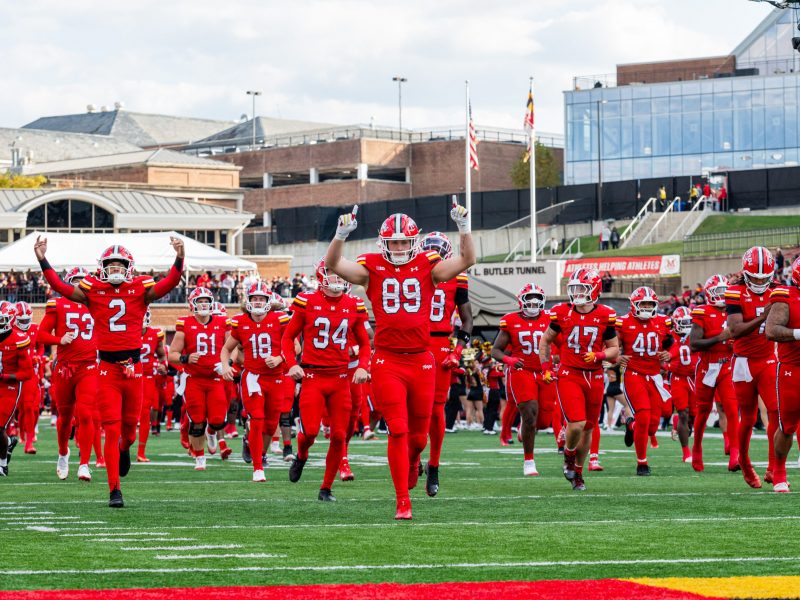When the Tawes Fine Arts Building opened in 1965, it was a state-of-the-art facility that excited the theatre and music departments to the point that they nicknamed it the “Tawes Mahal.”
Set designers could let their imaginations run wild on the spacious stage and new technology allowed for a gamut of special lighting and sound effects. The first production at Tawes, Showboat, featured a scaled-down showboat slowly moving across the stage on an invisible screen, according to the university’s 1966 yearbook.
Now the Tawes Fine Arts Building stands fenced off as workers begin the almost two-year-long renovation process to improve the nearly abandoned building. Since the theatre and music departments moved to the Clarice Smith Performing Arts Center in 2001, the former dressing rooms and practice rooms that are too small to be used as classrooms have remained empty.
When the $35.5 million renovations are done, the English Department will move into the building and enjoy new classrooms and offices, said Carlo Colella, director of architecture, engineering and construction. But the theater, which produced some of the most vivid Tawes memories for many students and alumni, will remain desolate, outdated and largely unused by the university.
“The wasted space makes me sad. I think there is something they could do with it,” said Martha Pogonowski, a 1977 graduate who performed in The Beaux Stratagem, One Flew Over the Cuckoo’s Nest and The Wizard of Id in Tawes. She described the theatre as having been “vibrant” while she was a student.
“It was fabulous,” she said. “We had everything we needed. At that point, [Tawes] was state-of-the-art.”
Imogene McCleary, a 1966 graduate, worked in the Tawes box office the first year the theatre was open and then performed in Oklahoma! in the theater in 1968.
“It was wonderful because it was so much nicer than the facilities that existed before,” she said, noting that Ritchie Coliseum and Woods Hall were used as theater venues before Tawes was built.
David Turowski, a 1982 graduate who performed in about a dozen shows, conceded that Tawes wasn’t the perfect theater but said he still treasured his time there.
“It seemed to be in good shape when I was there, but the longer I was there, I found its flaws,” Turowski said.
Tawes was less inviting than personal theaters because it was designed like a movie theater, he said. Students often had to find creative ways to bring the actors closer to the audience, such as building a platform over the first few rows of seats to extend the stage.
But Turowski said it was thrilling “as a young collegiate at the time, getting to perform in a 1,300-seat theatre.”
The space came in handy sometimes, such as for the 1978 production of Peter Pan. Students built a rotating turret in the back of the stage so that they could change the backdrops much like one would roll a giant roll of toilet paper, he said.
“There was always enough space and technology to do whatever we wanted for the shows,” Pogonowski agreed. “I just look back on my days at Maryland with such fondness and happiness.”
Current students have equally fond memories of Tawes performances, despite its dilapidated state.
Freshman business and math major Rebecca Hammer performed in Tawes in 2004 and 2005 during the National Invitational Theater Festival, when high schools from the East Coast are invited to perform at the university. It was Hammer’s first visit to the campus, and she said it provided her with a great first memory of College Park.
“Performing that night at theater festival and driving down [to College Park] was a lot more fun than performing in high school,” she said.
Hammer said she wishes the university would keep using Tawes for smaller productions instead of letting that space go to waste while all performances take place in CSPAC.
While CSPAC arguably caused Tawes’ downfall, few seem upset about the campus’s theater upgrade. Turowski called CSPAC “a real gem in College Park’s hat” and said, “That’s where theater ought to be done.”
“I don’t think the intensity, the love, the passion, the performance of the actors and actresses in CSPAC changes at all,” Pogonowski added. “What changes is the ability to bring new technology into the stage and improve the set.”
ecksteindbk@gmail.com


